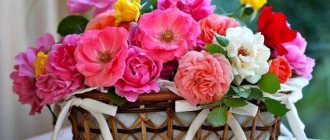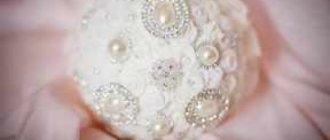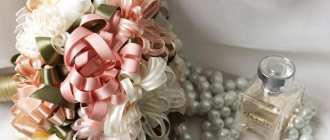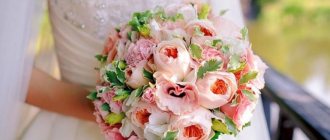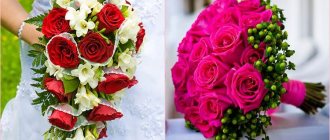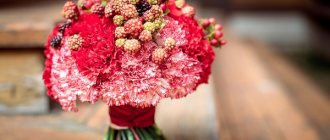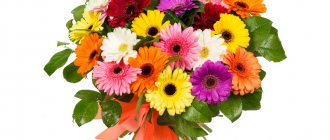Many, having heard the word “gypsophila”, remember flower tents, where there are a bunch of thin branches in a bucket, not yet sold, but already exhausted, which are shoved into each bouquet, without much meaning or taste. But this stereotype is far from the truth. Gypsophila is such a unique and amazing flower that it deserves special attention. At a wedding celebration, it will become a wonderful decoration due to its elegant sophistication; it is not for nothing that in England it is called baby's breath - “baby's breath”, and in Germany - “bride’s veil”.
Advantages
The lovely flower has long become not only the lifeline of any florist, rescuing any bouquet from trouble, but a full participant, and sometimes an honored guest, in weddings. Refined girls with impeccable taste and tired of templates choose gypsophila to decorate their outfits and as a wedding bouquet.
The floral arrangement, like a light haze, envelops the girl’s appearance, and as part of the decor of the wedding hall, it turns the room into a cloud palace, ascended to the seventh heaven. Modest girls, but with a rich inner world, who are alien to vulgarity and know for sure that beauty is hidden in the little things, will not be afraid to choose this flower.
Gypsophila has another great quality: it is perfectly preserved. It does not wither, much less rot, but simply dries out, without losing its external beauty. A dried twig will remain the same after years as it was when it was cut. This will allow you to preserve your wedding bouquet for many decades of happy family life.
Thus, this flower will be an impeccable choice due to its immutable advantages:
- durability under any conditions and uncomfortable handling;
- lightness and airiness (important when carrying a bouquet in your hand for many hours);
- low price;
- the ability to become a dried flower;
- compatibility with almost all colors.
Important! The only drawback of the plant is its allergenicity, especially when in excess. This must be taken into account when choosing a wedding bouquet.
Examples of wedding bouquets
With the help of gypsophila you can add simplicity and style to any wedding composition. It’s worth telling about a little trick related to plant branches. It lies in the fact that the balls themselves can be painted in absolutely any color.
It turns out that they will not necessarily be only white. Perhaps they will acquire a silver, pinkish, bluish color. Changing the color scheme is very easy.
For this, florists use regular spray cans. Moreover, the painted flower will not subsequently wither and this will not affect its freshness in any way.
To create a flower arrangement you will need:
- White Rose;
- white carnation;
- white hibiscus;
- white gypsophila.
The result will be an interesting light mono-bouquet for the bride. It is suitable for creating a romantic look. Be sure to place a few rose buds in the center, followed by carnations and hibiscus. In this case, gypsophila acts as a decorative end-to-end design.
Arrange several branches in a circle. In this option, it is possible to paint the gypsophila in a silver or pinkish color. The choice of gamma will depend on what result you would like to achieve.
Composition options
Gypsophila can decorate any bouquet. It emphasizes the tenderness of light delphinium and does not detract from the fragrant luxury of heavy peony, balancing the composition. Although gypsophila is beautiful in a duet with all flowers, there are still classic options for a wedding bouquet that are worth a closer look.
Roses and freesias
A classic and stylish option is a composition with roses. The Queen of Flowers is considered a symbol of love and is simply obliged to be present at the wedding. Roses of various colors and shapes with gypsophila become even more magnificent.
It is impossible to list all the variations of compositions with roses, because the imagination of florists is limitless. But the ornate buds, framed by the finest lace and strewn with pearls of small flowers, always look magical.
If the bouquet seems too classic, similar to the patterns of a cream cake, you can add freesias to the composition, which are strikingly different in shape from roses. Freesias will add a new touch, refresh and enliven the bouquet, especially if the roses are close in color to gypsophila, that is, cream, white or champagne.
Orchids
The orchid is very close to gypsophila in that it is just as hardy and tolerates discomfort very well. This flower will easily survive all the vicissitudes of the special day, without losing any of its freshness and charm.
Combining exotic luxury and modest beauty, they achieve a fantastic effect. With the help of orchids, beautiful cascading bouquets are created, where large star-shaped flowers are surrounded by the silvery glow of small pearl flowers. Thanks to the variety of colors, any color of the bouquet is available, matching the wedding dress or contrasting.
The only disadvantage is the high cost of such a bouquet , since orchids are not cheap flowers.
Tulips
A delightful, delicate flower perfect for a spring wedding. Bright juicy buds framed by snow-white lace look elegant and solemn.
Tulips are not strong plants, so they are treated with a special solution so that they can endure the long hours of the holiday. For decoration, flowers can be tied with an elegant ribbon.
White or pink flowers will make the bride's appearance sensual and delicate. They symbolize love and wealth, prophesying happiness for a couple entering into marriage.
Monobouquet
Creating a wedding bouquet is a real art that always evokes admiration. You can come up with a very complex design that is scary to touch, or you can choose one flower, your favorite, and create a masterpiece with it.
Information! A monobouquet is a composition with flowers of the same variety or with one flower at all.
Contrary to expectations, gypsophila is able to triumphantly play this role. Lush enough, tie the balloon with a beautiful ribbon, decorate it with a brooch - and the bride’s unforgettable accessory is ready!
Gypsophila goes perfectly with light summer dresses with a long train, creating an incredibly elegant image of the newlywed.
Celebration style
Ideal for a rustic wedding. This is a simple, close to nature, style that is at the intersection of rural and vintage weddings. The ceremony focuses on spontaneity and sincerity. There is no formality - formal suits, a classic white dress, a formal banquet hall.
Instead of black and snow-white colors, beige, milky, and flesh colors are present in the outfits. The outfits are looser, simple in style, without frills or luxury. The groom does not have to wear a three-piece; it can be replaced with a sand-colored vest. You can do without it altogether, and wear only a shirt and trousers with suspenders. Striped socks add spontaneity to the action.
Florists create three-dimensional compositions from gypsophila that look like clouds. It is used to decorate the backs of chairs, wedding arches and swings for photo shoots. Gypsophila goes perfectly with natural materials, especially wood, linen, and burlap.
How to prolong freshness?
The beauty of gypsophila is its durability. It does not require any special preparation - on a hot day of a summer celebration, a porta bouquet or just a damp sponge will be enough. Even when drying out, the plant does not lose its beauty. The plant demonstrates the same endurance in frost, which makes it indispensable for a winter wedding.
Since gypsophila thrives in conditions of long-term absence of water, it will not require special preparation for the wedding day. If the weather is too hot, the composition for the celebration is made in a porta bouquet or a special ball containing a damp sponge, but even with very long dehydration or drying, the plant does not lose its qualities, it still looks elegant and weightless. Guests will not notice any changes, and the bride herself will not feel discomfort from drooping inflorescences.
Cut gypsophila can last in a vase for up to two weeks, provided the water is changed regularly. Gradually turning into a dried flower, it will not lose its charm, which makes it an ideal choice for floral arrangements.
Botanical certificate
The plant has several names. The international classification uses the Latin designation Gypsophila - “loving gypsum”, which is associated with soil preferences. Under natural conditions, the plant chooses clayey areas with a high lime content. The second name of the popular herbaceous perennial is kachim. It belongs to the Carnation family.
The natural habitat of the cachima covers the southern regions of Europe, in particular the Mediterranean, East Asian countries and Australia. About 150 species are known belonging to the genus Gypsophila. All of them are distinguished by a highly branched stem, lanceolate leaves collected in a basal rosette and small flowers, reminiscent of a carnation in structure. The petals can be greenish, snow-white, or pink.
Kachim has been successfully cultivated by gardeners for a long time. The leaders in this area are considered to be the planters of Ecuador, who supply the market with very beautiful, double varieties with large inflorescences densely sitting on the branch. Dutch producers, thanks to special watering technologies, produce flowers in unnatural shades: green, blue, lilac, purple and others, which are also in demand among florists.
The most popular varieties for arrangements
It’s time to leave the idea of kachima as a banal filler for no less primitive bouquets in the past. The flower amazes with its variety of shapes, it seems like it was created for wedding floristry and such a universal component cannot be refused. Here are just a few varieties of gypsophila that allow you to turn your bridal bouquet into a modern, creative masterpiece.
| Variety | Description | Properties |
| "A Million Stars" | The branches resemble openwork lace or a mysterious veil that envelops the bride in a magical flair. The flowers are white, double, very small, and really look like a scattering of stars in the night sky. | The most fashionable variety used in romantic style wedding arrangements. |
| "Excellence" | Large-flowered variety. It is highly resistant to cutting and retains its whiteness when dried. | Serves as a background plant in mixes, used for interior decoration and furnishings, as well as for flower toys. |
| "Flamingo" | Reaches a height of 1 m. It has lush white-pink inflorescences, often of the double type. | Looks good in winter compositions, harmonizing with both living plants and dried flowers. Suitable for mono bouquets. |
| "Pink Star" | Tall - up to 70 cm stems are densely dotted with soft pink semi-double buds, reminiscent of miniature chrysanthemums. | Suitable for summer and spring arrangements of spherical or cascade type. Looks great with roses and peonies in powdery shades. |
| "Bristol Fairy" | Elongated - paniculate structure of the stems and miniature carnation-flowers, snow-white. | An excellent choice for rustic or eco-bouquets. |
| "Snow Maiden" | Openwork bushes, up to 50 cm high, are literally buried in large (up to 1 cm in diameter) double flowers, reminiscent of tiny snowballs. | Used primarily for pomanders and classic compositions on portbouquets. It tolerates low temperatures well, which makes it indispensable in winter. |
| "Valentine" | A unique variety with graceful purple-red petals. | Most often used for “hearts”, inscriptions or figures made from living plants that are included in wedding decor. |
Symbolism
Like every flower, gypsophila has its own meaning. Its delicate flowers, fragile branches and thin graceful leaves can only be associated with innocence and purity: both physical and spiritual.
Symbolizing virginity and inexperience, the flower also shows some frivolity of the young bride walking to the altar. It’s not for nothing that gypsophila is called the “bride’s veil” - it really, like a light cloud, accompanies a girl who is just entering adulthood in her life, uniting forever with her chosen one. Its white color harmonizes perfectly with the snow-white dress.
Important! This lovely light flower does not need to be accompanied by heavy scarlet roses or coldly solemn chrysanthemums. Even alone, they are able to create a light, incredibly airy holiday atmosphere.
Due to such a vivid interpretation of the symbolic meaning of gypsophila, it is not recommended for mature brides or those who are remarrying. For sophisticated ladies, there are luxurious, fragrant, beautiful flowers, and girlish modesty does not quite suit them.
Another symbol personified by gypsophila is not courage, but timidity. The young girl is pure and timid, like an angel descended from heaven. The discreet beauty of wonderful flowers on fragile stems with one stroke of the pen will describe the noble virtues of a beauty who, not without trepidation, entrusts her destiny to her chosen one.
Flower symbolism
Gypsophila in a bouquet speaks of purity, sincerity and nobility. What could be more innocent and beautiful than the breath of a child - this is exactly the kind of bright, unclouded soul that girls who choose an unusual plant for their wedding possess. Other flowers are also of great importance if they are present in the accessory. Roses symbolize all shades of love, orchids - admiration, peonies are associated with a happy marriage, and so on.
The presence of kachim makes any feelings higher and brighter. Just as in the arrangement, its delicate branches soften the contrasts, envelop the accent buds in a delicate haze, and add airiness. The British were the first to appreciate the exquisite beauty of representatives of the genus Gypsophila. They began to grow flowers in their gardens and decorate their rooms with them, admiring not only the originality, but also the resilience of the new culture. Later, the fashion for decorating wedding halls and arrangements with gypsophila was adopted by Americans and Canadians.
Today, it is with their light hand that the former “filer” has turned into one of the leading floristic trends. And it looks like he'll be sticking around for a long time.
Photo
Gypsophila will add elegance, lightness and grace to a flower arrangement, while perfectly complementing other flowers. A few photos and ideas for a bride’s wedding bouquet with gypsophila for inspiration:
What does the flower symbolize?
A bridal bouquet made from gypsophila is light and airy.
The plant is popularly called “tumbleweed.” In Germany it was called the “bridal veil”. Thanks to its delicate appearance, gypsophila has become associated with weightlessness, lightness, purity and sincerity. It’s not for nothing that another nickname for gypsophila is “baby’s breath.”
The plant symbolizes eternal love. In some cultures - frivolity. Paying attention to the symbolism of the accessory, it is worth remembering that each flower means a special feeling, mood or character. So, if you make a wedding bouquet of roses and gypsophila, the symbolic meaning will also change.
The choice of colors also matters. Pastel is closer to tender expressions of feelings, bright colors mean extravagance and passion.
Interesting! Gypsum lyubka is an unusually resistant plant. Maintains appearance in winter compositions. Dried flowers are used to create ikebana.
Master class on making a bouquet of carnations with your own hands
Do you want to have original wedding flowers for your wedding? Make your own bouquet. This way you will create a wedding accessory that will contain a piece of your heart and soul. And this will add a special charm to your creation, and will also convey through it your festive mood to the groom and all the guests at the celebration. When you look at your wedding photos years after your wedding, you will be pleased to see the floral masterpiece you created. You can tell an interesting story about its design to your future children.
To create a wedding floral accessory, the following plants are needed: lilies of the valley, myrtle branches, Turkish carnations, white hyacinths. We cut off the stems of all flowers and insert floral wire instead. This is done because the stems are thicker than the wire and when forming a composition with a large number of flowers, its handle will be too thick and uncomfortable. The wire bends well, which allows you to install the elements of the composition in the desired position. Materials and tools for creating a bouquet:
- Carnations – 11 pcs.
- Lilies of the valley – 15 pcs.
- Hyacinths – 10 pcs.
- Myrtle greens – 5 pcs.
- Floral wire - 45 cm for each flower.
- White satin ribbon – 1.5 m with a width of 1.5 cm.
- Scissors, glue, floral paper.
The process of creating a flower arrangement:
- It is best to make the composition a few hours before the ceremony. Freshly cut flowers should be placed in water for 3 hours before forming a bouquet.
- Take a clove and cut off its stems 3 cm below the bud.
- We pierce the stem at the base of the flower with wire (45 cm).
- We stretch the floral rod through the stem so that its ends are at the same level.
- We wrap the stem-wire with floral tape, starting from the puncture site and down to the end of the rod. We wrap the rod several times with tape. This is how we make an imitation of the stem.
- We take lilies of the valley and remove the leaves from them. We form them in bunches of 3-4 pieces. We wrap them with a floral rod and then with special paper. We leave the removed leaves from the lilies of the valley to form a bouquet.
- We collect 11 prepared carnations into a bunch in the shape of a heart. This must be done very gently, because these buds are too fragile. When you put them together, you will notice voids in the composition.
- We fill the empty spaces with prepared bunches of lilies of the valley, hyacinths, and myrtle branches. After this, we insert lily of the valley leaves into the voids of the bouquet. This way we get a composition with flowers directed outwards. We tie the stems with a special floral tape.
- We wrap the base of the composition in a spiral with a satin ribbon (1.5 cm wide). We secure it with glue and also with decor.

